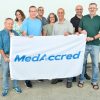That’s how Aaron Johnson, Marketing Manager for Accumold, defines what micro molding is, and why it’s becoming increasingly important in device manufacturing. In this Ask the Engineer interview with Medical Device Summit‘s Sangita Viswanathan, Johnson describes micromolding, and why device developers are increasingly seeking out this process for their devices.
Medical Device Summit (MDS): What is micro-molding?
Johnson: At Accumold, we believe true micro-molding involves much more than size or machine. When you speak of parts that weigh less than a gram, you may call it micromolding, but it takes more than size. We believe true micro-molding is also defined in terms of micro-features or complex geometries. It’s one thing to mold something small, it’s another thing to mold a micro part with extremely tight tolerances with complex shapes efficiently and precisely time and time again. Micro-molding must be capable of producing high-volume parts with the same precision. I find there are very few suppliers doing true, high-precision micromolding.
MDS: What are the general guidelines for micro-molding?
Johnson: This is probably the most often asked question we get and the answer is somewhat complex. On the one hand micro-molding is still and injection molding process. So many of the same general molding principles will still apply such as gating, part ejection, parting line locations and draft. On the other hand the part size, geometries and even the material choice can have a profound effect on the outcome depending on the particular situation. What is possible with micro-molding is often very part dependent making general guides difficult to articulate. For example, we typically say a 6:1 aspect ratio is a good rule of thumb in terms of wall thickness to length. However in one study we did to test material choice and feature performance we found one material ran a 3:1 ratio over a .003” wall thickness and another ran 42:1. Same mold, same part design, different materials with profoundly different results. When you’re dealing with small sizes and features there is very little in terms of data sheets or guides that will be helpful. It’s usually the expertise of the micro-molder that brings the guidance.
MDS: What are advantages of medical devices manufactured using the micromolding process?
Johnson: Medical sector is a huge market for anything micro especially with the demand for more minimally-invasive devices and personal diagnostics. There is high pressure for device manufactures to do more in smaller and smaller spaces. Imaging, device deployment, drug delivery or surgical tools are just some of the medical devices with these demanding designs. There is also a strong desire in the medical field for these complex products to be disposable. Certainly micro plastics is an enabling technology for that as well.
MDS: What are some of the challenges involved with micromolding?
Johnson: Sometimes the material specifications and the part design don’t match up. For instance, PEEK is highly desirable in medical device development because of its bio-compatibility, however it’s not always the easiest material to fill in small spaces. We have also found there is a desire for exotic medical grade materials like biodegradable or bioabsorbable resins but those come with other manufacturing challenges. Materials like that require clean room molding, a very specific manufacturing procedure and the general part handling requirements are very strict. These added requirements can sometimes make it cost-prohibitive to make the part.





